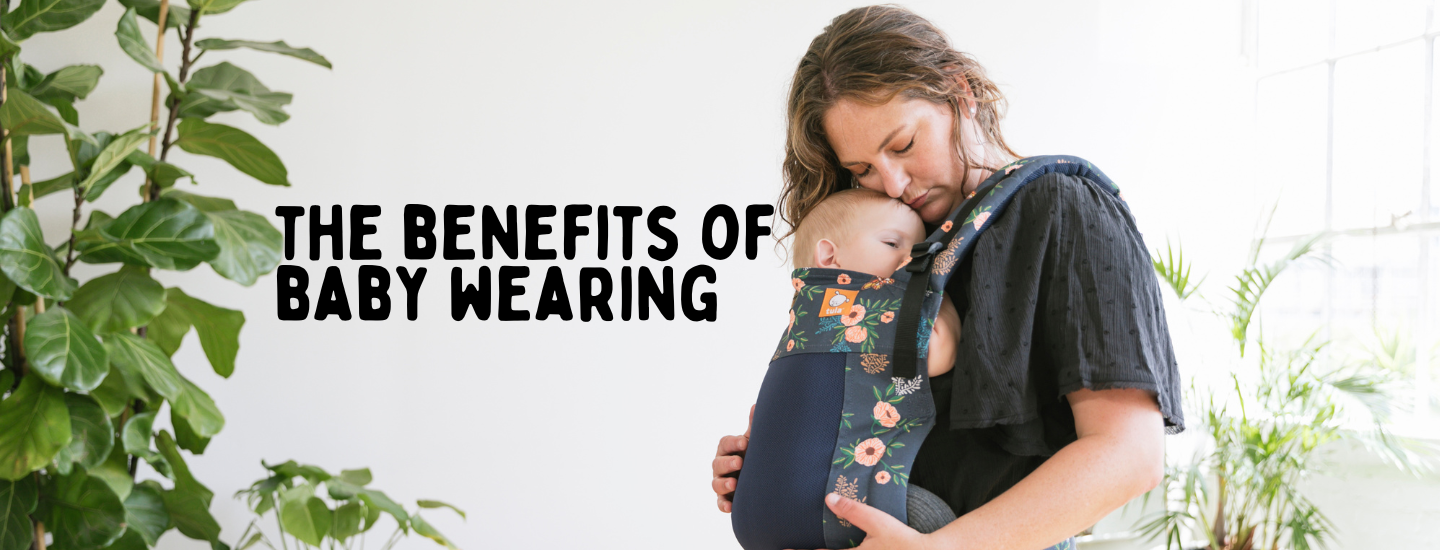The Benefits of Wearing your Baby
Babywearing is an instinctual parenting style, firmly engrained in the history and evolution of the human species. It refers to the simple practice of carrying a baby in a baby carrier, sling or pouch, and provides a multitude of benefits for both infant and caregiver.
Here at TKC we recognise these are valuable in early years parenting for the following reasons:
Caregiver bonding

Babywearing helps to promote the bonding process between caregiver and baby, helping to create a strong and secure attachment which is critical for a baby's healthy emotional development. While being held, a child can hear and feel their caregivers heartbeat, breathe in their scent, and feel their warmth. This helps to create a strong connection and sense of connection between caregiver and infant, which is oh so important.
With a front row seat to the world, the higher vantage point that being carried provides can help to stimulate the senses, support cognitive development, and even language development. When we consider the evidence that children who spend time in outward facing pushchairs develop language skills at a slower pace than those inward facing pushchairs, this seems an obvious benefit to babywearing. Where a child is virtually face-to-face with people on a regular basis, they will naturally pick up valuable cues and language recognition, developing sociability.
Babywearing makes daily parenting easier. It does. Whether running errands, doing household chores, parenting older siblings, or even working, by wearing your infant in a baby carrier you can keep them safe, content and calm, while going about your daily activities, with hands free! Of course, care should always been taken and judgement calls made depending on the tasks you're undertaking- for example, if cooking, moving your baby from a front carry position to a back one is a safer option to reduce the risk of injury.

Studies indicate that infants who are carried cry less, and exhibit lower levels of stress hormones in their bloodstream. When frequently carried, babies tend to fall asleep more quickly, and sleep more soundly and for longer periods while nestled in a comfortable carrier.
You may be familiar with the term "kangaroo care", which was originally applied in the study of premature babies. Research has shown that holding a preemie baby against bare skin for as much as possible throughout the day can lead to quicker weight gain. This practice can benefits all babies, as studies suggest that it helps to regulate their heart rate, respiratory rate, and body temperature.
When it comes to holding babies, babywearing provides a natural and ergonomic position that supports the hips and spine. This position, referred to as the "seated M-position", keeps the knees higher than the bottom and evenly distributes weight while providing proper spinal support. High-quality baby slings, like the Tula Baby Carrier, encourage this spread-squat M-position, which can help to prevent hip problems in children who are at risk of them.
The NHS recommends using baby carriers to help prevent Plagiocephaly, a condition in which portions of the skull bones become flattened due to extended periods of lying on the back. Carrying a baby in an upright position during waking hours naturally lowers the risk of the condition as an infant spend less time lying on their back.
How to carry your baby safely
When wearing your baby in a sling or carrier, it is important to remember the T.I.C.K.S rules for safe babywearing. These are:
TIGHT
Your baby carrier should be tight enough to hug your baby close to you as this will be most comfortable for you both. Any slack/loose fabric will allow your baby to slump down in the carrier which can hinder their breathing and pull on your back.
IN VIEW AT ALL TIMES
You should always be able to see your baby's face by simple glancing down. The fabric of the sling or carrier should not close around them so you have to open it to check on them. In a cradle position your baby should face upwards and not be turned in towards your body.
CLOSE ENOUGH TO KISS
Your baby's head should be as close to your chin as it comfortable. By tipping your head forward you should be able to kiss your baby on the head or forehead.
KEEP CHIN OFF THE CHEST
A baby should never be curled so their chin is forced onto their chest as this can restrict their breathing. Ensure there is always a space of at least a finger width under your baby's chin.
SUPPORTED BACK
In an upright carrier a baby should be held comfortably close to the wearer so their back is supported in its natural position and their tummy and chest are against you. If a sling is too loose they can slump which can partially close their airway. A baby in a cradle carry in a pouch or ring sling should be positioned carefully with their bottom in the deepest part so the sling does not fold them in half pressing their child to their chest.
Baby wearing is a practical and comfortable way to care for an infant, and can help to promote a strong and secure bond attachment It has many benefits for both child and caregiver, and if you're keen to try it for yourself take a look at our range here. We only stock tried and tested baby carriers that we know and love.
Laura Davies is the founder of the The Kid Collective, the ultimate shopping destination for toys that support learning through play. Everything is consciously selected with the benefits of play in mind, ensuring that each toy inspires growth in children, for today and tomorrow. When it comes to play, we know what matters. Laura has personal experience with babywearing, and is a trained Babywearing Peer Supporter.
.png)



